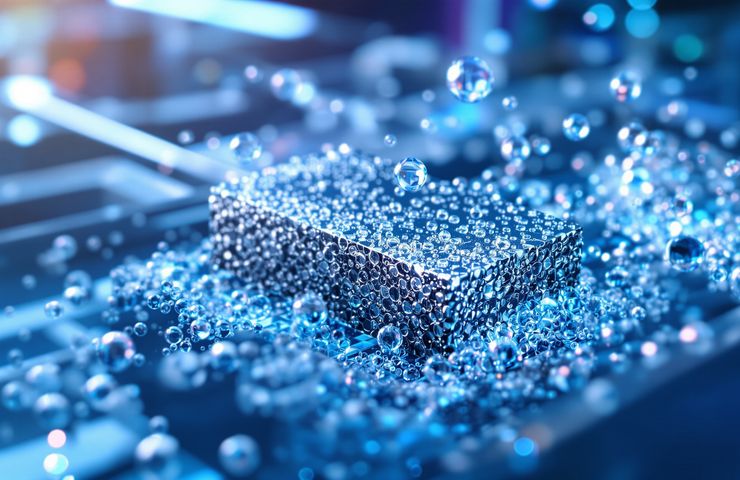
Purine-Modified Platinum Electrodes Revolutionize Green Hydrogen Production
October 27, 2025Over at Chiba University in Chiba Prefecture, Japan, a research team just dialed up the excitement in water electrolysis. In their paper in the International Journal of Hydrogen Energy, Dr. Syunnosuke Tanaka and Prof. Masashi Nakamura unveiled a smart trick: they wrapped platinum electrodes in purine bases—the very DNA and RNA building blocks we learned about in biology class. But this isn’t just a neat lab stunt—it’s a confirmed game-changer that cranks up HER efficiency by 4.2 times and trims platinum requirements by over fourfold through platinum reduction. It’s a fresh spin on something we thought was old news: splitting water molecules to harvest eco-friendly fuel. And by tackling the cost and material hurdles head-on, these purine-modified platinum electrodes could finally nudge green hydrogen past the tipping point. Stay tuned—this could rewrite the rulebook for sustainable energy production.
Water electrolysis has been on research radar for more than a century, but it’s still been hamstrung by sky-high costs. In most modern electrolyzers, platinum is the MVP at the cathode, guiding protons to form hydrogen gas with surgical precision. Yet that comes at a steep price—literally. Even small lab stacks can demand tens of thousands of dollars in platinum alone. Over the years, people have chased all sorts of workarounds—alternative catalysts, fancy alloys and complex reactor designs—only to hit fresh roadblocks. The holy grail has always been the same: cutting back on platinum while cranking up performance.
And let’s not forget supply-chain drama. Platinum is a rare beast, and its price can swing wildly if mining hiccups or geopolitical tensions pop up. That volatility makes financiers jittery about green hydrogen projects. That’s why nailing down a reliable path to platinum reduction is more than just a lab victory—it’s a potential game-winner for getting green hydrogen off the bench and into real-world applications.
Chiba Prefecture sits just east of Tokyo, boasting a mix of industrial hubs, research institutes and picturesque coastal scenery. Chiba University’s Graduate School of Engineering, in particular, has earned a reputation for pushing materials science and renewable-energy tech to new frontiers. Dr. Tanaka’s lab isn’t some small operation—it’s a bustling collaboration drawing in chemists, materials engineers and computational whizzes from around the globe. They’ve already chalked up several wins designing next-gen catalysts, from corrosion-resistant alloys to novel nanomaterials. So when these researchers say they’ve found a clever bio-inspired tweak for platinum, it’s worth sitting up and paying attention.
The Secret Sauce: Purine Bases on Platinum
So, what’s the scoop? The team gently blankets the platinum surface with purine molecules like adenine and guanine—those same compounds you memorized in school when learning about nucleic acids. These purines then form a kind of hydrogen-bonded mesh with neighboring water molecules, creating a cage-like network that lowers the energy barrier for hydrogen ions (protons) to pair up and form H2 gas. Think of it as an electrocatalyst with built-in bio-coffee, energizing the reaction and speeding up the Volmer step in the hydrogen evolution reaction cycle. It’s a sweet blend of biochemistry and electrochemistry, letting nature’s tried-and-true components boost a cutting-edge energy tech.
What’s neat is how tunable this chemistry is. By tweaking the purine concentration and deposition time, they can dial in just the right coverage—not too thick to block the metal, but enough to reshape the local electric field. And it’s not a one-trick pony: the purine shell works in both acidic and alkaline conditions, demonstrating robust performance across the pH spectrum. That versatility alone makes it a tempting candidate for widespread adoption in the green hydrogen arena.
To make sure it wasn’t just storytelling, the group ran a suite of surface analyses—X-ray photoelectron spectroscopy (XPS) to tease out chemical states, transmission electron microscopy (TEM) to visualize coverage, and even in-situ spectroelectrochemical tests to watch the magic happen in real time. Complementary computational simulations confirmed that purine adsorption tweaks the hydrogen adsorption energy just enough to speed up the reaction without over-binding the intermediates. The bottom line: a 4.2-fold boost in overall activity and a solid 3.2-fold uptick in alkaline media compared to bare Pt/C catalysts.
Kicking Platinum Scarcity to the Curb
Here’s the kicker: fewer grams of platinum, more output—exactly what we’ve been dreaming of. In standard Pt/C setups, you’re looking at around 0.5 mg of platinum per square centimeter to hit your design current densities. With this purine biorganic coating, you can slash that load by more than fourfold and still hit the same or higher performance. That’s serious platinum reduction right there, driving down capital costs and shrinking the levelized cost of hydrogen—an all-important metric for any green hydrogen rollout.
And it gets hotter: because the purine molecules tweak the local electronic environment, each platinum atom becomes more of a catalytic superstar. Active site density climbs, turnover frequencies go through the roof, and you end up squeezing more hydrogen out of less metal. That efficiency boost is a major stride toward making water electrolysis stacks leaner, meaner and ready for mass production.
Built for the Future: Real-World Impact
Let’s talk targets: the U.S. Department of Energy has laid down the gauntlet—achieve $2 per kg of green H2 by 2025 and smash through to $1 per kg by 2030. The European Union’s Fit for 55 package and Japan’s national hydrogen roadmap are singing the same tune, pushing for clean fuels to undercut fossil options. Now, thanks to Chiba’s purine-infused electrodes, those numbers look a lot less pie-in-the-sky. Cutting catalyst costs directly translates to cheaper hydrogen, making it a more viable contender for power generation, seasonal energy storage and feedstock for heavy industry.
What’s more, this pigmentation-like process slots neatly into existing manufacturing lines—you won’t need to rebuild facilities from scratch. Imagine electrolyzer plants tucked alongside wind farms or solar parks, churning out clean hydrogen on demand with leaner capital expenditures and smaller footprints. That flexibility could be the nudge project developers need to greenlight the next wave of installations, from gigawatt-scale hubs to decentralized, off-grid systems.
By driving down upfront costs and simplifying stack design, these purine-modified platinum electrodes are poised to make green hydrogen not just a lab marvel but a market reality.
Collateral Impacts: Beyond the Lab Bench
This breakthrough isn’t just about geeky metrics and lab reports—it has real-world ripple effects that could reshape industries and economies:
- Heavy-duty transport: Fuel-cell trucks and buses can finally run on cleaner, cheaper hydrogen, cutting diesel dependency and emissions on long-haul routes.
- Industrial processes: Hydrogen’s a key ingredient for ammonia, methanol and steel production. Lower-cost H2 means greener fertilizers and building materials.
- Energy storage: Large-scale hydrogen hubs smooth out the peaks and valleys of solar and wind power, turning surplus energy into a dispatchable fuel.
- Regional job growth: New lines manufacturing purine-modified catalysts and assembling electrolyzer stacks can spark high-tech job creation in manufacturing hubs.
- Circular economy: Cutting platinum mining helps lighten the environmental footprint of metal extraction, aligning with sustainable resource management principles.
From cleaner roads and greener factories to more stable grids and local economic boosts, the fallout from this innovation could span far beyond the lab bench.
The Real Kicker: Scaling and Durability
No shiny new catalyst gets crowned without proving it can last the marathon, not just the sprint. While lab studies are great for showing off initial spurt performance, real-world electrolyzers need to run for thousands of hours without faltering. That means stress tests under varied currents, temperature swings, contaminants and startup-shutdown cycles. The Chiba team isn’t blind to these hurdles—they’re already lining up partner pilots to test these purine-coated electrodes on an industrial scale.
Initial plans call for stacking them into pilot electrolyzers later this year, aiming for at least 3,000+ operational hours before any serious de-ratings show up. If the electrodes keep their edge, we could see commercial demos within two to three years—sooner than many of us thought possible.
This approach has already cleared peer review and independent validation, ticking the boxes for policy frameworks from the U.S. DOE’s cost targets to the European Hydrogen Strategy. With all these pieces in place, the clean hydrogen future might arrive faster than you can say H2.
Bottom line: By borrowing chemistry from DNA and RNA’s purine bases, Chiba University has crafted a next-gen catalyst that could finally tip the scales for green hydrogen. More H2 for fewer resources—that’s a breakthrough worth standing up for. Buckle up, because the age of affordable, scalable hydrogen production is practically here.
source: techxplore.com


 With over 15 years of reporting hydrogen news, we are your premier source for the latest updates and insights in hydrogen and renewable energy.
With over 15 years of reporting hydrogen news, we are your premier source for the latest updates and insights in hydrogen and renewable energy.